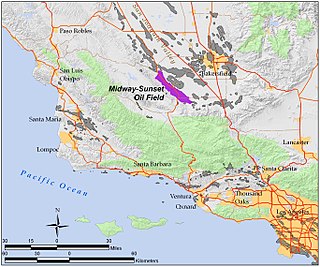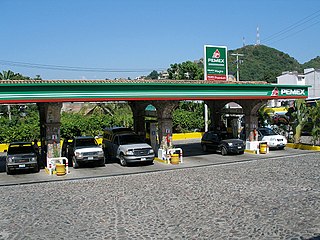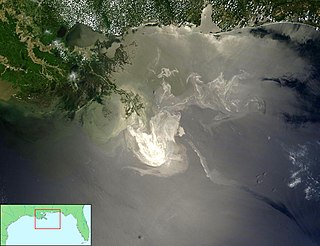Related Research Articles

The history of the petroleum industry in the United States goes back to the early 19th century, although the indigenous peoples, like many ancient societies, have used petroleum seeps since prehistoric times; where found, these seeps signaled the growth of the industry from the earliest discoveries to the more recent.

An oil spill is the release of a liquid petroleum hydrocarbon into the environment, especially the marine ecosystem, due to human activity, and is a form of pollution. The term is usually given to marine oil spills, where oil is released into the ocean or coastal waters, but spills may also occur on land. Oil spills can result from the release of crude oil from tankers, offshore platforms, drilling rigs, and wells. They may also involve spills of refined petroleum products, such as gasoline and diesel fuel, as well as their by-products. Additionally, heavier fuels used by large ships, such as bunker fuel, or spills of any oily refuse or waste oil, contribute to such incidents. These spills can have severe environmental and economic consequences.

Fergana, or Ferghana, also Farghana is a district-level city and the capital of Fergana Region in eastern Uzbekistan. Fergana is about 320 km east of Tashkent, about 75 km southwest of Andijan, and less than 20 km from the Kyrgyzstan border. The modern city was founded in 1876.

The Gulf War oil spill, or the "Persian Gulf oil spill", was one of the largest oil spills in history, resulting from the Gulf War in 1991. In January 1991, Iraqi forces allegedly began dumping oil into the Persian Gulf to stop a U.S. coalition-led water landing on their shores. Despite quite high initial estimates, the amount of oil spilled was likely about 4,000,000 US barrels. Within the following months of the spill, most clean-up was targeted at recovering oil, and very little clean-up was done on Saudi Arabia’s highly affected beaches. An initial study in 1993 found that the spill will not have long-term environmental consequences, but many studies since 1991 have concluded the opposite, claiming that the spill is responsible for environmental damage to coastline sediments and marine species and ecosystems. Considered an act of environmental terrorism, the spill was a heated political move that had implications for the larger Gulf War and temporarily damaged Kuwait and Saudi Arabia.

Ixtoc 1 was an exploratory oil well being drilled by the semi-submersible drilling rig Sedco 135 in the Bay of Campeche of the Gulf of Mexico, about 100 km (62 mi) northwest of Ciudad del Carmen, Campeche in waters 50 m (164 ft) deep. On 3 June 1979, the well suffered a blowout resulting in the largest oil spill in history at its time. To-date, it remains the second largest marine oil spill in history after the Deepwater Horizon oil spill.

A blowout is the uncontrolled release of crude oil and/or natural gas from an oil well or gas well after pressure control systems have failed. Modern wells have blowout preventers intended to prevent such an occurrence. An accidental spark during a blowout can lead to a catastrophic oil or gas fire.

The Lakeview Gusher was an eruption of hydrocarbons from a pressurized oil well in the Midway-Sunset Oil Field in Kern County, California, in 1910. Caused by a blowout, it created the largest accidental oil spill in history, lasting 18 months and releasing an estimated 9 million barrels of crude oil.
Prudhoe Bay Oil Field is a large oil field on Alaska's North Slope. It is the largest oil field in North America, covering 213,543 acres (86,418 ha) and originally contained approximately 25 billion barrels (4.0×109 m3) of oil. The amount of recoverable oil in the field is more than double that of the next largest field in the United States by acreage (the East Texas Oil Field), while the largest by reserves is the Permian Basin (North America). The field was operated by BP; partners were ExxonMobil and ConocoPhillips until August 2019; when BP sold all its Alaska assets to Hilcorp.

The Santa Barbara oil spill occurred in January and February 1969 in the Santa Barbara Channel, near the city of Santa Barbara in Southern California. It was the largest oil spill in United States waters at the time. It remains the largest oil spill to have occurred in the waters off California.

The Midway-Sunset Oil Field is a large oil field in Kern County, San Joaquin Valley, California in the United States. It is the largest known oilfield in California and also the largest oil field in the country by total oil in place, though Alaska's Prudhoe Bay Oil Field and the East Texas Oil Field have larger total production values of over 13 billion barrels and 5.4 billion barrels respectively compared to Midway-Sunset which has produced nearly 4 billion barrels.

The petroleum industry in Mexico makes Mexico the eleventh largest producer of oil in the world and the thirteenth largest in terms of net exports. Mexico has the seventeenth largest oil reserves in the world, and it is the fourth largest oil producer in the Western Hemisphere behind the United States, Canada and Brazil. Mexico is a member of OPEC+ and the North American Free Trade Agreement.

The Lost Hills Oil Field is a large oil field in the Lost Hills Range, north of the town of Lost Hills in western Kern County, California, in the United States.

BP p.l.c. is a British multinational oil and gas company headquartered in London, England. It is one of the oil and gas "supermajors" and one of the world's largest companies measured by revenues and profits. It is a vertically integrated company operating in all areas of the oil and gas industry, including exploration and extraction, refining, distribution and marketing, power generation, and trading.

Leduc No. 1 was a major crude oil discovery made near Leduc, Alberta, Canada, on February 13, 1947. It provided the geological key to Alberta's most prolific conventional oil reserves and resulted in a boom in petroleum exploration and development across Western Canada. The discovery transformed the Alberta economy; oil and gas supplanted farming as the primary industry and resulted in the province becoming one of the richest in the country. Nationally, the discovery allowed Canada to become self-sufficient within a decade and ultimately a major exporter of oil.

Greka Energy, legally HVI Cat Canyon Inc., is a privately held company engaged in hydrocarbon exploration principally in Santa Barbara County, California. Formed in 1999 after the acquisition and merger of several smaller firms, it is a subsidiary of Greka Integrated, Inc., a holding company headquartered in Santa Maria, California, and is wholly owned by Randeep Grewal.

Offshore oil and gas in the Gulf of Mexico is a major source of oil and natural gas in the United States. The western and central Gulf of Mexico, which includes offshore Texas, Louisiana, Mississippi, and Alabama, is one of the major petroleum-producing areas of the United States. Oil production from US federal waters in the Gulf of Mexico reached an all-time annual high of 1.65 million barrels per day in 2017. Oil production is expected to continue the upward trend in 2018 and 2019, based on ten new oil fields which are planned to start production in those years. According to the Energy Information Administration, "Gulf of Mexico federal offshore oil production accounts for 15% of total U.S. crude oil production and federal offshore natural gas production in the Gulf accounts for 5% of total U.S. dry production."

The 2010 oil spill from Deepwater Horizon was an environmental disaster off the coast of the United States in the Gulf of Mexico, on the BP-operated Macondo Prospect. It is considered the largest marine oil spill in the history of the petroleum industry and estimated to be 8 to 31 percent larger in volume than the previous largest, the Ixtoc I oil spill, also in the Gulf of Mexico. Caused in the aftermath of a blowout and explosion on the Deepwater Horizon oil platform, the United States federal government estimated the total discharge at 4.9 million barrels. After several failed efforts to contain the flow, the well was declared sealed on 19 September 2010. Reports in early 2012 indicated that the well site was still leaking. The Deepwater Horizon oil spill is regarded as one of the largest environmental disasters in world history.
The Mingbulak oil field is an oil field in the Fergana Valley in Uzbekistan. It was first developed in 1992, but abandoned after a massive oil spill. In 2010 it was scheduled to be exploited by Uzbekneftegaz.
This is a list of notable events relating to the environment in 1992. They relate to environmental law, conservation, environmentalism and environmental issues.

The California oil and gas industry has been a major economic and cultural component of the US state of California for over a century. Oil production was a minor factor in the 19th century, with kerosene replacing whale oil and lubricants becoming essential to the machine age. Oil became a major California industry in the 20th century with the discovery on new fields around Los Angeles and the San Joaquin Valley, and the dramatic increase in demand for gasoline to fuel automobiles and trucks. In 1900 California pumped 4 million barrels (640,000 m3), nearly 5% of the national supply. Then came a series of major discoveries, and the state pumped 100 million bbl (16 million m3) in 1914, or 38% of the national supply. In 2012 California produced 197 million bbl (31 million m3) of crude oil, out of the total 2,375 million bbl (378 million m3) of oil produced in the US, representing 8.3% of national production. California drilling operations and oil production are concentrated primarily in Kern County, San Joaquin Valley and the Los Angeles basin.
References
- ↑ Barcelo, Damia (2014). The Handbook of Environmental Chemistry 27. Verlag Berlin Heidelberg: Springer. p. 4. ISBN 978-3-642-38475-2.
- ↑ Fingas, Merv (2013). The Basics of Oil Spill Cleanup. Boca Raton FL: CRC Press. p. 10. ISBN 978-1-4398-6246-9.
- ↑ Kaushik, Garima (2015). Applied Environmental Biotechnology: Present Scenario and Future Trends. New Delhi: Springer. p. 132. ISBN 978-81-322-2123-4.